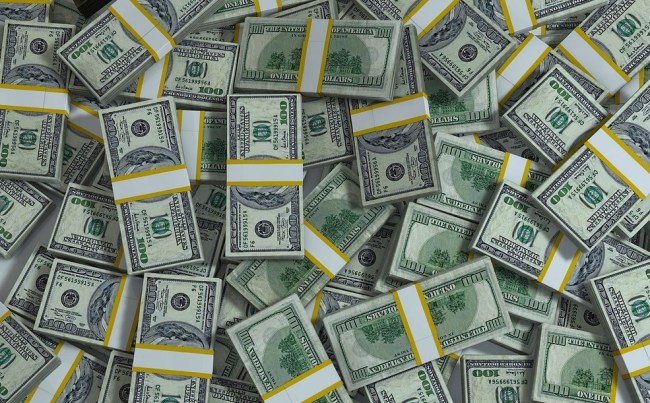
Pixabay
Fake money in movies and TV shows looks legit AF, right? Well, there’s a really good reason for that, and it’s because the process to print the currency is almost more grueling than the real bills we use every single day. That’s for obvious reasons — because the government can’t let all this fake money floating around for people to try and use — so the rules and regulations for the prop cash is pretty intense.
Sure, it’d be easy to slap a couple dead presidents’ pictures on some paper and hand it all over to a producer on set of a movie or TV show, but one of the largest prop companies in showbiz, RJR Props in Atlanta, goes to extreme lengths to make sure their fake money meets certain criteria so not to get busted.
In a recent interview with CNN, RJR Props’ founder, Rich “RJ” Rappaport, talked about some of the day-to-day responsibilities he has to do before printing and/or delivering his fake money — which has been featured in movies like The Wolf of Wall Street and The Fast and the Furious, to name a few. Rappaport’s duties include talking to the Secret Service and even sitting around burning fake money his company printed to try and make it look as real as possible for the cameras.
RJ said he speaks directly with the government to comply with federal rules while finding ways to create the best possible fake dollars. He makes two types: one for close-ups and one that will look real from about 15 inches away. He calls them high grade and standard grade.
“Our standard grade prop money is printed on both sides, but has an optical illusion built into it. It looks realistic at an arm’s length, but when you start bringing it closer, it actually changes over and it reveals itself as fake.” The trick, he said, is to make it look real on camera but fake if somebody tries to spend it at a store.
“We also have a high grade type, better known as close up money. That’s the one you use for a close-up scene, or if somebody is counting money and putting it in someone else’s hands. That looks fantastic. But since it looks so real, we can print it on one side only.”
Want to see how real RJR Props’ high grade fake money really looks? Here’s a picture of the prop cash from the company’s Facebook page.
[protected-iframe id=”a25b05aba7e3f8844ef35d37484101fc-97886205-21275894″ info=”https://www.facebook.com/plugins/post.php?href=https%3A%2F%2Fwww.facebook.com%2Frjrprops%2Fposts%2F1547781978854452&width=500″ width=”500″ height=”764″ frameborder=”0″ style=”border:none;overflow:hidden” scrolling=”no”]
As you can see from the pic above, the fake money looks about as legit as the $1 bill you have in your pocket right now. But there are some major differences between the fake stuff and real currency that helps prohibit anyone from trying to actually use it.
Per CNN:
Instead of “United States Federal Reserve,” the words under the “100” in the top left corner read “Unreal Fake Currency Reserve.” The artwork of Franklin’s face has been done from scratch, and doesn’t have his name underneath it. The seal is a different design, and the two signatures actually read “Ima Not Real” and “Not Real Currency” instead of the names of the Treasurer of the United States (changed to “Treasurer of the Treasurer”) and the Secretary of the Treasury (turned into “Secretary of the Secretary”). Nothing survives the scrutiny: even “United States” is spelled with a “W” instead of a “U.”
As for cost, the fake money from RJR Props sells its standard stack of 100 bills for $45 per stack, while the high grade stack of 100 runs for $65. For an extra $20, the prop company will spend hours and lots of man power distressing the bills to make it look more realistic and not so crisp. And that process sounds… interesting.
“It’s very difficult to make, harder than people would imagine. It’s made by hand. Every bill is wrinkled, creased, stained, cigarette-burned. Everything that you might find on money in circulation, that’s what we do to it. It’s a difficult process, usually requiring 15 or 20 people sitting around a table.”
The entire operation sounds pretty awesome, but it’s one that requires lots of security and lots of moving parts.
In addition to the movies and TV shows that RJR Props prints fake money for, they also supply plenty for music videos, too — with artists like Kendrick Lamar and 50 Cent using the cash before. And, while Rappaport says the company gets hit up “probably 20 times a week” for his fake money to be used in videos, he does say some artists still do use real money; he just can’t tell you who those people are.
“Yes, actually there are a number of artists who use real money,” Rappaport revealed. “But I can’t say who uses real money and who uses fake money because it would be a security risk.”
Rappaport’s company also provides other props for movies and TV shows — like fake cocaine and war missiles — so this dude seems like he’s got one of the best jobs on the planet. You can read more about some of the operation over on CNN.com.
(H/T CNN)